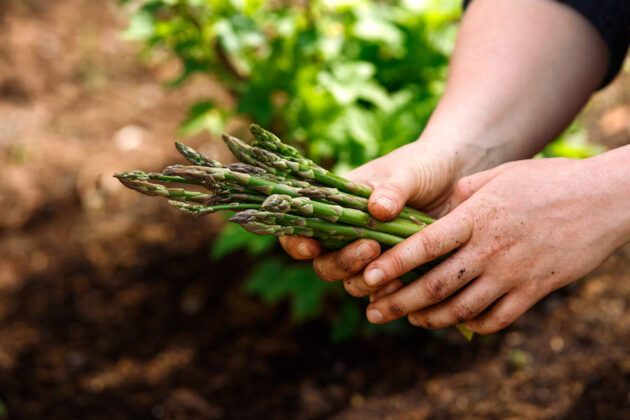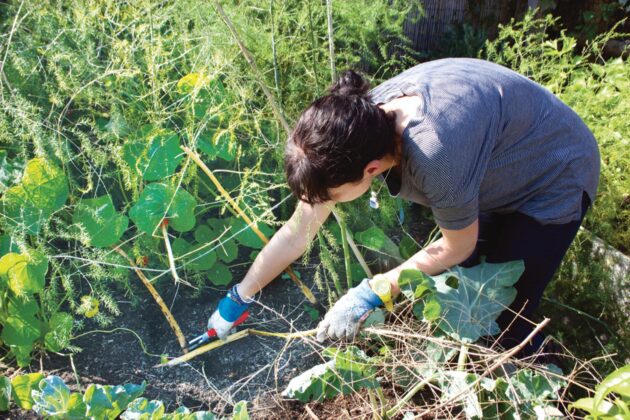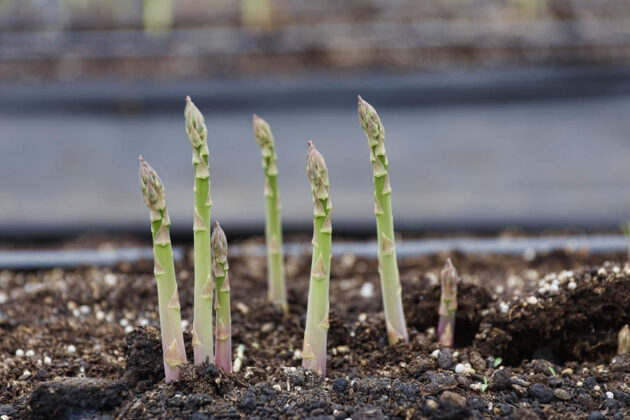Patience wins out here (and saves money)
Spring comes along and hopefully so does asparagus. For more than 20 millennia, we’ve consumed these tender, young buds and stalks as they begin to grow in spring. (Find The Field’s asparagus recipes here.)
Whether you purchase your asparagus from the supermarket, the greengrocer or the farm gate, it can be difficult to see these pricy spears as good value until you grow your own asparagus. Patience is key here. (Read: asparagus is the best of British)
What to know when you grow your own asparagus
When planted as year olds, asparagus crowns won’t be up to full harvesting speed for at least two years. However, a perennial plant, asparagus can produce spears for more than 10 years without requiring lifting and dividing.
Where space is tight, it can be hard to see permanent plantings in the prime sun of a potager as a worthwhile investment – until you cook those very first spears.
While you can plant asparagus in deep pots, experience says it is best planted in the ground or in a raised bed where it benefits from a generous depth of soil. Mindful laying out of the beds, allowing 30cm between each planted row and a 75cm path, will create maximum planting and adequate path space to work.
Farmyard manure
Michael Bourne has been growing asparagus at New Park Farm in Kent for almost 25 years and is quick to share the formula behind his success: “Plenty of farmyard manure is our secret ingredient,” he discloses with a laugh. “The crowns are deep-rooting and demand plenty of organic material.”
Preparation is the secret. Prepare the soil thoroughly in the autumn. Dig your beds to a spade’s depth, unless you have clay-rich soil, in which case, add 20cm to allow for the layer of stone, gravel and broken-up bricks needed to enhance drainage. As you put soil back into the beds, gradually add a barrow of matured manure to every three square metres.
Leave the surface of the soil roughly level, allowing the frost to work on the texture over winter. In March, prepare your planting tilth by forking and raking the soil and adding a general fertiliser (something with an NPK balance of 5-10-10), as the final tilth is achieved. Top up your maturing manure pile and have plenty of this fertiliser to hand: you’ll be dressing the top of the asparagus bed with the former each October and the latter in March.
Which asparagus to grow?
Once you’ve expended all that energy improving the soil and prepping your bed, not to mention gearing up for the long wait, you’ll need to pick the right asparagus for your soil and your palate. Bourne recommends, “Stick with the tried and tested and avoid the weird and wonderful.”
Hybrid vigour is the revenge of the mutt: the combining of two disparate gene pools produces stronger and higher-yielding types that top the lists of best varieties. Because they don’t waste time and energy producing seedlings to further the species, male-dominant varieties will produce more spears, so if you are looking for volume, go with the boys.
Late March or early April, just as the soil starts to warm up and plants start to contemplate growing, is the ideal time to plant asparagus. If you’ve chosen a variety that isn’t readily available as a crown, or you have patience to spare, asparagus is easily sown from seed. Simply sow the seed in drills, just over 1cm deep and 15cm apart. Once the seedlings appear, thin them to 30cm apart. In March the following year, carefully lift each new crown and plant out, as you would bought crowns.
Although you can find two- and even three-year-old crowns, don’t be suckered into purchasing anything other than year olds. Older ones can be a false economy since they can suffer more in the transplanting and take longer to settle in and flourish than the cheaper year-old crowns.
When your plants arrive, soak them thoroughly for a day to replenish the moisture lost in transit, and keep them wrapped in damp sacks or newspaper so that the crown is exposed but not the roots.
The most critical factor to picking a planting date is soil: dry soil is not only easier to work with, but critical to achieving the balance between eliminating air pockets around the roots and not compacting the soil.
Planting asparagus
- Do not plant into sticky, wet soil.
- Prepare each row by digging a trench 30cm wide and 20cm deep.
- Mix some agricultural grit with some of the excavated soil and, using this, create an 8cm-high, mounded ridge running down the centre of the trench.
- Place the crowns 30cm apart along the top of the ridge with the roots spread out down either side of the mound.
- Use the remaining soil to cover the roots to the level of the top of the crowns, so the soil level is 12cm below the surface of the bed.
- As the plants grow, spread a little more soil over the roots to keep them covered.
- The ridge that forms will push the asparagus plants to put down deep roots, which will pay dividends above the ground.
“Ridging up around the spears supports the top-heavy ferns,” explains Bourne. He recommends ridging up a further 10cm each year.

Digging an asparagus trench
Weeding
After the initial preparation of the bed, the biggest investment in asparagus is weeding by hand. Weeds compete with asparagus for water and nutrients, and can be a host for disease and pests, so keeping your bed weed-free is critical to achieving the highest possible yields. Use a short cut, like a hoe, at your peril as it is all too easy to damage emerging spears.
Perennial weeds are nigh on impossible to eliminate from asparagus once they have got a foothold. Keep a pot of selective weedkiller such as glyphosate to hand, and try using a paintbrush to apply it in a targeted way.
When to stop picking asparagus
In late June each year, restraint will be required to stop picking asparagus and allow the establishment of ferns, the leafy stems that feed the crown and roots. “Fern growth is the most important time,” Bourne emphasises. “Photosynthesis at this stage establishes the next year’s production, so don’t let your asparagus blow over or get trodden on by the dog.”
The delicate, feathery ferns should be allowed to grow right through when they turn golden brown to the first hard frosts. Once the stems have been cut to ground level, be sure to remove and either compost or burn them. Fern left on or near asparagus beds acts as a vector for disease, increasing the risk that you might take the disease into the following year. (Find all our asparagus recipes here.)
Asparagus pests and disease
The pests and disease that plague asparagus are every bit as glamorous as the plant itself (aside from the omnipresent and pedestrian slug, of course). There’s the innocuous and easily remedied chocolate spot, identifiable by brown streaks and blotches on leaf and stem, caused by a paucity of potash or phosphate in the soil. And, of course, the more lethal violet root rot, the death knell for an asparagus planting. As the name implies, the tips of the roots are attacked by a fungus that leaves a web of violet below the soil, and yellow, dying plants above it. Ridding your precious bed of this scourge can be achieved only by isolating the infected areas and then burning the diseased plants.
Even the asparagus beetles are gorgeous, sporting a bright-red, dark-blue and cream casing, worthy of any medieval military coat of arms, or a tomato-red casing with 12 black spots. Together, the beetles and their grubs can make quick work of laying waste to the foliage. Should the worst happen, leave around three stems of asparagus at the end of each row to serve as Pied Pipers and clear fell the rest of your plants, removing all the rest of the foliage. The beetles that fall to the ground will make for the remaining foliage where they can be isolated and dealt with.
Getting established
Establishing your asparagus successfully is all about practising the restraint and self-control necessary to enable the asparagus fronds to feed the root system that will put a surfeit of spears on plates in years to come.
No spears should be cut in the first season. And, in the second, only a single spear (one of the thicker ones) from each plant should be cut. In the third year, all the asparagus that appears can be cut for the first five weeks, and in the fourth year (and for the following six years), all of the spears can be cut for six weeks.
Asparagus is ready to cut when it reaches 10cm above the surface of the bed: any taller and the stems will become woody. Using a sharp knife cut the stalks at about 10cm, below the ground.
There’s absolutely no point in putting all the effort and patience into growing asparagus if you are not going to consume it at its best: freshly cut spears should be on the plate within two hours of picking. From the minute asparagus is cut, the plant’s sugars begin to turn to starch, a process that affects both the taste and texture of each stalk and sets homegrown apart.

Some top varieties of asparagus
Guelph Millennium
Michael Bourne’s top recommendation – this hardy, all-male Canadian F1 hybrid has that extra bit of hardy vigour needed to tolerate even the cold of northern potagers.
Gijnlim
Bourne recommends the Lim hybrids as thoroughly tested and harvestable from the first year. An RHS award winner, this male-dominant F1 hybrid produces heavy crops on sandy or clay soils in early to mid season.
Backlim
Another of the Lim stable of varieties, this all-male F1 hybrid performs mid to late season, producing good yields of thick spears, with tips that stay closed later than other types.
Connover’s Colossal
The RHS Award of Garden Merit is testament to the quality of the large, purple-tipped spears this open-pollinated variety produces en masse. Very popular and widely available.
Martha Washington
This open-pollinated variety’s long, thick spears have caused it to become an old American favourite. It was named after the US’s first First Lady.
Jersey Giant
This F1 male-dominant hybrid is another all-American variety. It is famed for the flavour of its thick, straight spears.
Jersey Knight
As it’s ready to pick a little later than the Jersey Giant, you can extend your season with this extremely flavourful, tender-speared, all-male F1 hybrid variety.
Eros
The is the Italian stallion of F1 hybrids. It is a good choice for heavier soils, thriving on clay as well as sand, and producing impressive green spears with purple tips.
Pacific Purple
Good enough to eat raw, the sweet, tender and completely purple spears are the hallmark of this prolific F1 hybrid.
Ordering asparagus crowns
Michael Bourne of New Park Farm takes pre-orders for crowns from November, lifting in March and despatching from April until mid May.
This article was originally published in 2012 and has been updated.








